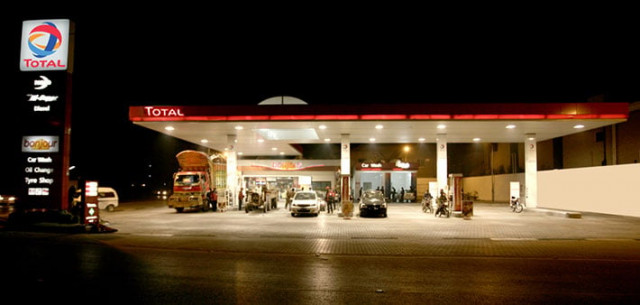Pollution risks by petrol pumps
Varying amounts of vapours are emitted from car fuel tanks during filling

We pass through a smog season every winter which impairs social and economic life in our major cities, especially in Punjab. Schools are closed and the children and the elderly fall sick.
We have, in the recent past, described the source of problems and the solutions thereof in a number of pieces. In this space, we will discuss the pollution and health impact of petrol pumps and the need for introducing controls in this respect.
Petrol pumps sell gasoline, diesel and a variety of petroleum products like lubricants. Petrol pumps are usually responsible for a considerable emission of gasoline vapours, which are toxic and carcinogenic.
Varying amounts of gasoline vapours are emitted from cars’ fuel tanks during the filling of gasoline. Also gasoline vapours are emitted during the filling of underground storage tanks when being filled by gasoline bowsers and make their way through a vent shaft, which is usually provided in storage tanks.
Gasoline vapours contain volatile organic compounds (VOCs), which affect human health and cause ozone pollution. NOx and VOCs can undergo a number of chemical reactions with sunlight, heat, ammonia, moisture, and other compounds to form the noxious vapours, ground-level ozone and particles that comprise smog.
It should be noted that the ground-level ozone is dangerous and toxic while sky-level ozone has a positive function, which blocks ingress of violet rays into the human atmosphere. Chlorofluorocarbons (CFCs), which are used in sprays, have been banned because CFCs break the protective ozone layer.
Automotive exhausts also emit NOx, CO2 and VOCs due to incomplete combustion. Thus, both automotives and petrol pumps’ vapour emissions are responsible for the creation of ozone and smog.
Vapour emissions from petrol pumps have been underestimated and often ignored. It has been shown by studies that vapour emissions from petrol pumps are indeed significant and can extend to a distance of more than 300 feet from the petrol pumps.
Read Air pollution haunts twin cities’ dwellers
However, earlier studies had lower estimates, which have given rise to liberal location laws for the petrol pumps. In the meantime, technology has developed on-board vapour recovery systems, which are beyond the scope of Pakistan and this paper.
In order to control vapour emissions from petrol pumps, two types of gasoline vapour recovery systems (VRS) are provided in the regulatory laws of industrialised countries.
Stage 2 System deals with vapour recovery from car tanks, which is sucked by the filler itself through an annular pipe and a pump.
Stage 1 deals with vapour recovery from storage tanks, which used to be vented hitherto in most industrialised jurisdictions, but it is no more the case. It continues to be the case in developing countries. The vapours recovered are recycled.
All petrol pumps are not required to install vapour recovery systems. Smaller low-sales petrol pumps are exempted from the installation of vapour recovery systems.
It also depends on the location and population density of the area. In some locations, in the US, petrol pumps having sales of more than 600,000-840,000 gallons per year are required to install the system.
While most industrialised countries have regulations requiring the installation of vapour recovery systems in petrol pumps exceeding sales beyond a certain volume, developing countries are lagging behind.
Recently, India has issued vapour recovery regulations. In large cities, large petrol pumps have installed such systems. But the numbers are not high.
Read Soaring pollution in Lahore fills wards with sick children
Petitions have been filed by activists in environmental tribunals against oil companies. Indian government has now become stricter and has issued deadlines in this respect.
Indian rules require a sales limit beyond 100 KL per month in locations having a population of one million or more for the installation of vapour recovery system. The threshold limit is 300 KL and a population of 100,000 to 1 million.
There are 10,000 petrol pumps in Pakistan, of which reportedly many are unlicensed and illegal ones. Petrol pumps located on high traffic flow roads in large cities may be required to install such systems.
Volume of sales has to be a criterion as well. A study should be conducted to collect vapour emission densities at petrol pumps and appropriate regulations and rules be developed.
One should also study the cost of the system and its possible impact on petrol prices.
Reportedly, Pakistan State Oil (PSO) has started working on a pilot study in this respect. Others should also be encouraged to do such studies. Environmental agencies should also be involved in impact studies.
If found feasible, the vapour recovery system may help reduce pollution and smog in the critical and sensitive areas in Pakistan.
The minimum that can be done is to use the cover associated with the gasoline filling gun, which covers the car tank inlet, for stopping the release of vapours outside. Often, one finds such a cover missing, which pollutes the whereabouts, affects workers and even customers.
Petrol pump workers can be worst affected. Their regular medical check-up should be introduced as well.
The writer is former member energy, Planning Commission and an author of several books on the energy sector
Published in The Express Tribune, January 22nd, 2024.
Like Business on Facebook, follow @TribuneBiz on Twitter to stay informed and join in the conversation.


















COMMENTS
Comments are moderated and generally will be posted if they are on-topic and not abusive.
For more information, please see our Comments FAQ